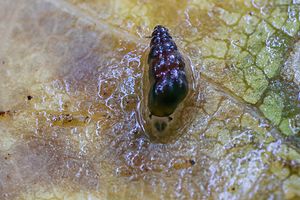Potamopyrgus oppidanus facts for kids
Quick facts for kids Potamopyrgus oppidanus |
|
|---|---|
 |
|
| Conservation status | |
 Nationally Critical (NZ TCS) |
|
| Scientific classification | |
| Genus: |
Potamopyrgus
|
| Species: |
oppidanus
|
Potamopyrgus oppidanus is a tiny freshwater snail. It's a type of gastropod mollusk. This special snail lives only in New Zealand. You can find it in just one small area in Wellington.
Contents
Meet the Wellington Snail!
This small snail was first described in 2008. A scientist named Martin Haase found it. He collected samples from a stream in Wadestown, Wellington.
What Does It Look Like?
This snail is very small. It's about 3 millimeters long. That's roughly the size of a tiny ant! It's also just over 1 millimeter wide. Its shell is a light brown color. The shell is also a bit see-through. The snail's body can have patchy colors. It also has two black stripes on its head.
Where Does It Live?
The P. oppidanus snail is endemic to New Zealand. This means it lives nowhere else in the world. It has only been found on Te Ahumairangi Hill. This hill is in the town belt of Wellington.
The snail was first discovered near a fountain. This fountain was close to Grant Road and Wadestown Road. However, the stream near the fountain was later moved. It was put into a man-made stream bed. Because of this, the snails can no longer be found there.
What Kind of Home Does It Like?
P. oppidanus snails like damp and shady places. They live among fallen leaves and small stones. They also like woody bits that have fallen from trees. These are places where they can stay hidden and moist.
Why Is It Endangered?
This snail has a "Nationally Critical" conservation status. This is under New Zealand's Department of Conservation system. It's given this status because it lives in a very small area. The total space it occupies is less than 1 hectare. That's about the size of a small sports field. It's also found in only one location.
The International Union for Conservation of Nature (IUCN) also calls it critically endangered. Its population is getting smaller. The IUCN sees many threats to this snail. These include new buildings and businesses. Changes to its habitat are also a problem. There's also a risk of fires. Pollution in its freshwater home is another danger.
Experts suggest protecting the snail's known home. They also recommend protecting the plants around it. More research is needed on where the snail lives. Scientists also want to learn about its life and what threatens it.
A recent check showed its population is still going down. People building illegal mountain bike tracks hurt its home. A weed called Tradescantia fluminensis is also a problem. This weed smothers the snail's habitat.


